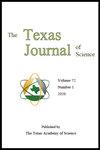TARDIGRADES IN TEXAS: FIFTH GRADERS COLLABORATE TO ADD THREE NEW RECORDS TO THE STATE
Q4 Agricultural and Biological Sciences
引用次数: 0
Abstract
Tardigrades, or water bears, are resilient microscopic animals found in terrestrial and aquatic habitats. Because tardigrades can be easily found and yet are understudied, fifth graders from Hill Elementary in the Austin Independent School District in Texas collaborated with their teacher and an expert to conduct a biodiversity survey of microscopic animals found in lichens and mosses on their school campus. These ten-year-olds learned to differentiate between tardigrades, rotifers, and nematodes as they collected samples from different habitats. In their first year of study, they observed 520 microscopic animals and found differences in their diversity and distribution patterns. A second study of 14 samples revealed 68 tardigrades from eight identified species, representing two classes, four orders, and five genera. Three of these species have never been recorded from the state of Texas and represent the first records for the state: Viridiscus perviridis (Ramazzotti, 1959), Milnesium cf. alpigenum (Ehrenberg, 1853), and Milnesium cf. brachyungue (Binda & Pilato, 1990). Furthermore, Mil. alpigenum and Mil. brachyungue were previously unknown in North America, thus representing the first records for both species on the continent. This experience demonstrates that students challenged with basic research questions can learn to conduct field research, carry out scientific surveys, collaborate with scientists and discover new knowledge. In this case, students learned to find tardigrades and contributed to our overall understanding of this phylum.得克萨斯州的缓步动物:五年级学生合作为该州增加三项新纪录
缓步动物,或水熊,是在陆地和水生栖息地发现的适应性强的微观动物。由于缓步动物很容易被发现,但却没有得到充分的研究,德克萨斯州奥斯汀独立学区希尔小学的五年级学生与他们的老师和一位专家合作,对校园里地衣和苔藓中发现的微观动物进行了生物多样性调查。这些10岁的孩子在从不同的栖息地收集样本的过程中学会了区分缓步动物、轮虫和线虫。在第一年的研究中,他们观察了520种微观动物,发现了它们的多样性和分布模式的差异。对14个样本的第二项研究显示,68种缓步动物来自8个已确定的物种,代表2纲4目5属。其中三种从未在德克萨斯州记录过,它们是该州的第一次记录:Viridiscus perviridis (Ramazzotti, 1959)、Milnesium cf. alpigenum (Ehrenberg, 1853)和Milnesium cf. brachyungue (Binda & Pilato, 1990)。此外,milo . alpigenum和milo . brachyungue此前在北美是未知的,因此代表了这两个物种在大陆上的第一次记录。这一经验表明,受到基础研究问题挑战的学生可以学会进行实地研究、开展科学调查、与科学家合作并发现新知识。在这种情况下,学生们学会了寻找缓步动物,并为我们对这一门的全面了解做出了贡献。
本文章由计算机程序翻译,如有差异,请以英文原文为准。
求助全文
约1分钟内获得全文
求助全文
来源期刊

The Texas Journal of Science
Agricultural and Biological Sciences-Ecology, Evolution, Behavior and Systematics
CiteScore
0.50
自引率
0.00%
发文量
2
期刊介绍:
Scholarly manuscripts reporting original research results in any field of science or technology, including science education, will be considered for publication in The Texas Journal of Science. Prior to acceptance, each manuscript will be reviewed by both knowledgeable peers and the editorial staff. Authors are encouraged to suggest the names and addresses of two potential reviewers to the Manuscript Editor at the time of submission of their manuscript.
 求助内容:
求助内容: 应助结果提醒方式:
应助结果提醒方式:


